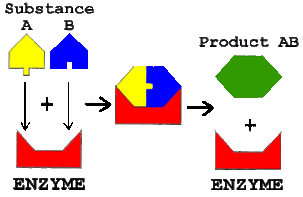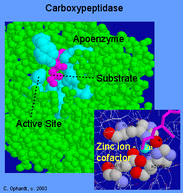What are enzymes?
Enzymes increase the reaction rate without changing the chemical makeup of a reaction. Most information about enzymes has been discovered due to the extraction and isolation of enzymes from cells and are put to work in test tubes. There are around 3,000 enzymes within each individual cell. If one enzyme were to be defective or missing, it can be disastrous.
| Parts of an Enzyme
|
Enzyme Nomenclature
Enzymes are generally named in correlation to the substrate molecule it is reacting with. They end in -ases to the root name of the molecule. A few enzymes such as pepsin, trypsin, and chymotrypsin, which catalyze the hydrolysis or proteins, were named before the naming system was created.
Type of EnzymeOxidases/Dehydrogenases Transferases Hydrolases Lyases Isomerases Ligases/Synthetases | ReactionOxidation-reduction Functional group transfer Hydrolysis Addition to double bonds (or reverse) Isomerization Formation of bonds with ATP cleavage |
(x)
How Enzymes Work
 click image for source
click image for source Enzymes bind to their substrate with an active site. An active site is a cleft or groove on the surface of an enzyme made up of amino acids. Inside the active site is where the enzymatic catalysts occurs. The substrate binds to the active site in a variation of bonds, such as hydrogen bonds, ionic bonds or hydrophobic interactions. Each enzyme-substrate interactions are different and specific to the pair. Therefore, only the correct substrate can bind to with the enzyme.
Once the substrate has bonded to the enzyme, the reaction takes place. The reaction may be determined by the nature of the enzyme. An enzyme may "couple two different reactions". This means that with an endothermic one, it can allow the enzyme to drive the endothermic reaction by using the energy given off by the exothermic reaction. In this process, ATP is the fuel that powers the required energy in living organisms.
(x)
Once the substrate has bonded to the enzyme, the reaction takes place. The reaction may be determined by the nature of the enzyme. An enzyme may "couple two different reactions". This means that with an endothermic one, it can allow the enzyme to drive the endothermic reaction by using the energy given off by the exothermic reaction. In this process, ATP is the fuel that powers the required energy in living organisms.
(x)


